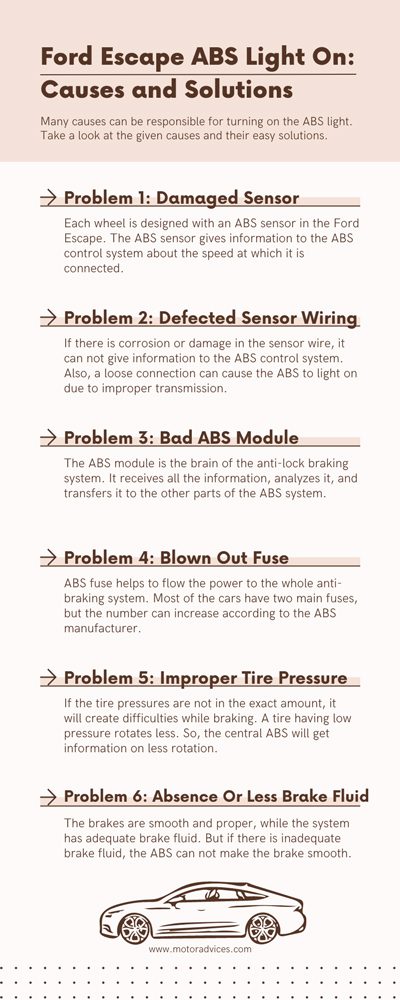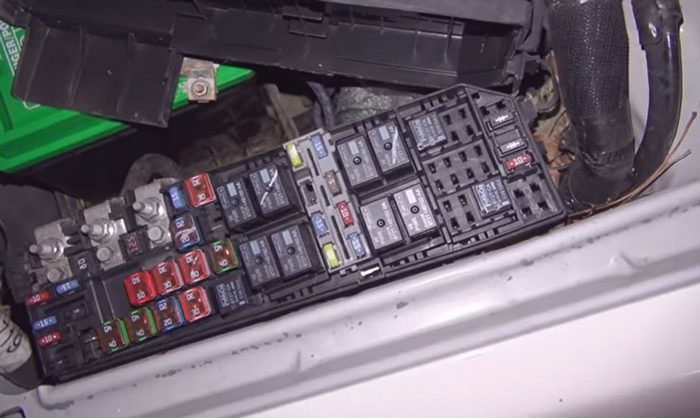Ford Escape ABS Light On: Causes and How to Reset It?
The ABS light can turn on only if there are any problems in the braking system. So, what are the causes of the Ford Escape ABS light on, and how to reset it?
There are several reasons that can light up your Ford Escape’s ABS light. The reasons include the following.
- Bad ABS sensor or wheel sensor
- Presence of any damaged wire
- Imbalance of tire pressure
- Low brake fluid
- A blown-out ABS fuse
- Damaged ABS module
I will discuss the reasons in detail in this guide. You will also get the solutions to all these problems here as well. Also, an easy trick to reset your ABS is given here.
Ford Escape ABS Light On: Causes and Solutions
ABS or Anti-lock braking system makes the brake smooth and pleasant. But if the ABS light turns on in the dashboard, that means there is a problem with the ABS or braking system.

Many causes can be responsible for turning on the ABS light. Take a look at the given causes and their easy solutions.
Problem 1: Damaged Sensor
Each wheel is designed with an ABS sensor in the Ford Escape. The ABS sensor gives information to the ABS control system about the speed at which it is connected.
If one or more sensors get damaged, then the central ABS will not get information. Then, the ABS light will turn on. This will result in the failure of the speedometer and ABS while braking.

Solution:
If the sensor is damaged, then you have to replace it with a new one. But before replacing it, you have to examine which one is bad among the four sensors. Use the OBD2 reader to find out the bad one. You can detect the bad sensor by following this process:
- Connect the OBD2 scanner with your car.
- Turn it on.
- Select the ‘Smart Vin’ option.
- Press OK, and then press left.
- Select the ‘Control module’ option.
- Here, many options will appear. Select the ‘RBS’ or ‘ABS’ option.
- Now, you can select the ‘Read code’ or ‘Live data’ option to read the wheel sensor codes. C0040 is the code for the faulty wheel speed sensor.
To change the damaged sensor, you should follow these steps:
- Disconnect the negative battery terminal.
- Jerk the car up and make it safe for work.
- Carefully rotate the nuts of the wheel anticlockwise. Then, remove the tire.
- Find out the wheel sensor connection part behind the disk.
- A cleaner can make your work easy. So spray on the connecting part and leave it for at least 10 minutes.
- Remove the bolts that hold the wire of the sensor.
- Now, remove the sensor and its wire from the wheel.
- Set the new sensor on the wheel and screw the bolt tightly.
- Set the wire the same as the previous manner and fix all the screws.
- Connect the negative battery terminal.
- Screw the wheel in position and remove the jerk.
Problem 2: Defected Sensor Wiring
If there is corrosion or damage in the sensor wire, it can not give information to the ABS control system. Also, a loose connection can cause the ABS to light on due to improper transmission. It will also cause the failure of the speedometer, stability, and traction.

Solution:
You should not seal the damaged wire if the ABS wire is damaged or corroded. Rather, you have to change the ABS sensor or the wiring. Changing the wires and the ABS sensor costs almost the same.
So, it is good to change the ABS sensor if the wire is damaged. Please follow the steps from the solution of “Problem 1: Damaged Sensor” to replace the sensor.
Problem 3: Bad ABS Module
The ABS module is the brain of the anti-lock braking system. It receives all the information, analyzes it, and transfers it to the other parts of the ABS system. Also, it acts as a relay station for all the functions of the ABS parts.
The ABS light will turn on if the ABS pump is not working properly. Ultimately, you can not smoothly handle the pedal, and the brakes can get locked up.

Solution:
If the ABS module or pump is not working at all, then replacing it is the only solution. It is better to take your car to the repair shop or call a professional. You can follow these steps to replace it with the help of an experienced person.
- Open the hood.
- Find the abs module.
- Disconnect all the wires from the module.
- Take it back out of the car.
- Now, insert the new ABS module carefully without damaging any structure.
- Plug back the connection following the previous manner.
Problem 4: Blown Out Fuse
ABS fuse helps to flow the power to the whole anti-braking system. Most of the cars have two main fuses, but the number can increase according to the ABS manufacturer.
If one is blown out, the whole system will stop working. Ultimately, the ABS light will turn on as there will be no circulation of power.
A loosely inserted fuse also hampers power flow. If it is not connected well, it can not be part of the system. Ultimately, the power can not pass through the desired place due to discontinuation. It will result in long-distance braking and locking up the wheel.

Solution:
You need to first check if the ABS fuse is broken or not.
- Open the hood.
- Remove the black negative cable from the battery.
- Open the lid of the fuse box.
- Follow the diagram given on the lid and locate the ABS fuses.
- Carefully remove the ABS fuses.
- Inspect the fuse. If there is a sign of burning, blown out, or melting circuit inside, then replace it.
- Also, if there is any debris, moisture, or corrosion inside, replace the fuse too.
Here is a video to help you find the location of the ABS fuses in the Ford Escape.
Problem 5: Improper Tire Pressure
If the tire pressures are not in the exact amount, it will create difficulties while braking. A tire having low pressure rotates less. So, the central ABS will get information on less rotation. At that moment, the ABS light will turn on to inform the driver of the problem. You can feel the whole car or steering wheel shaking while driving.
Solution:
Check the exact tire pressure of each wheel in the manual or inside the car’s door.
- Monitor the pressure of the four wheels. The pressure mainly remains between 30 to 35 psi. Below this level means low tire pressure.
- Inflate the tire if the pressure level is below the requirement.
- Repeat this process if other tires have low pressure.
Problem 6: Absence Or Less Brake Fluid
The brakes are smooth and proper, while the system has adequate brake fluid. But if there is inadequate brake fluid, the ABS can not make the brake smooth.
This will influence the central anti-braking system to turn the light on. Any leakage or not filling the reservoir for a long time is the main reason behind this problem. It will cause difficulties, noise or vibration while braking.

Solution:
First, find if there is any leakage present or not. If present, then seal it.
- Evacuate the reservoir with a suction tube.
- Jerk up the car.
- Unscrew the wheels.
- Locate the brake bleeder nipple behind the disk.
- Unscrew the bleeder.
- Connect the suction tube with the bleeder and loose the bleeder.
- Do not remove it until properly drained of all the fluid.
- Screw back after draining.
- Follow this process for the four wheels in the right rear, left rear, right front, and left front.
- Fill the reservoir with new brake fluid.
You can fix most of the problems by yourself. But if you haven’t ever fixed it before, it is good to get help from an expert.
How To Reset Ford Escape ABS Light?
After fixing the issues, the ABS light may go off itself. But if the light stays on even after fixing the underlying issues, you have to reset the ABS light manually.

Resetting ABS Light By Disconnecting the Battery
- Turn the ignition on, but do not start the car.
- Open the hood.
- Disconnect the negative battery terminal. Keep the battery disconnected for 15 to 20 minutes.
- Now connect the negative battery terminal back to the position and screw tight.
- Turn off the ignition, then again on it. Start the car, and the ABS light will disappear.
Resetting the ABS Light By Using the OBDII Scanner
You can also follow the following process with OBD2 tools to reset the ABS light:
- Plug in the connector of the OBD2 scanner in the car.
- Turn on the ignition. Remember that you should not start the engine at this time.
- Start pumping the brake one time in one second. Repeat this for at least 8 times.
- Start the engine for 5 to 10 seconds and turn it off.
- Disconnect the OBD2 wire from your car.
- Start the car, and the ABS light will no longer remain turning on.
FAQs
These are some commonly asked questions by people about ABS light illumination issues in the Ford Escape.
Yes, ABS warning lights are serious. It indicates that your car’s ABS system is faulty and is on the way to getting unsafe. So, before getting into unsafe conditions or any major damage occurring, detect the problem and fix it.
You can drive your car with the ABS light on. But the braking process will not be easy for you. You have to be more careful to drive a car with an ABS light on.
Conclusion
Immediately fixing the problems behind a turned-on ABS light is crucial. The solutions given are easy to follow. But if you are unable to do so, then you should go to the repair shop or get help from a professional mechanic. Neglecting the problems for a long time can cause an unwanted condition.
Regular servicing includes the ABS and the braking systems as well. To reduce risks, you should regularly perform basic maintenance to keep everything in pristine working conditions.

